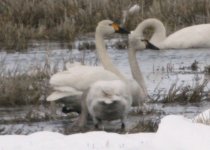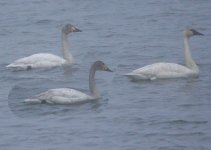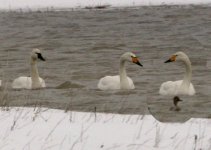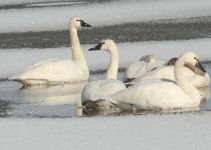Chris Benesh
So much work, so little time...so let's go birding
Hi All,
Occasionally, I run across a particular swan that leaves me scratching my head a bit. Though I can recognize a classic Bewick's Swan and a classic Whistling Swan, I am still troubled by some of the 'tweeners that are out there. Since they are but subspecies, I shouldn't really be surprised to find birds that appear intermediate, but nonetheless, there is the drive to want to ascribe them to one form or the other. Today I photographed a swan in southern Oregon that had extensive yellow loral skin. It was not as extensive as on the more yellow-billed forms of Bewick's, and there was no yellow over the top of the bill base, but in surfing through images of Bewick's Swans, there are examples with similar minimal amounts of yellow from the western Palearctic. Here is one example:
http://tinyurl.com/26ljg8
I have also included another shot I took this summer of three Tundra Swans seen on St. Paul Island, Alaska. They were widely regarded as being two Bewick's and one Whistling. The photo has been altered slightly to fit them into a tigher crop, since they were slightly more spread out in the original shot. There is one clear-cut Bewick's and one clear cut Whistling. The third bird has reduced yellow in the lores, much like the swan I saw today. I have looked through thousands of Tundra Swans in North America, and while I have seen a lot of variation, this represents the most yellow that I've seen on a bird that was not clearly a Bewick's. There was a clear Bewick's in the same general area last year (Klamath Basin), but that bird had very extensive yellow that connected over the top of the bill at the base. So the notion of a Bewick's Swan occurring along the Oregon-California border is not too far-fetched.
Anyway, I'm looking for input from birders from both sides of the pond. Do these 'tweeners look like Bewick Swans, and do North American birders see Whistling Swans showing this extensive of yellow in the lores? Before it gets raised by someone else, the yellow lores appear marginally more extensive than that illustrated by Sibley for extreme yellow-billed Whistlings in his field guide.
Chris
Occasionally, I run across a particular swan that leaves me scratching my head a bit. Though I can recognize a classic Bewick's Swan and a classic Whistling Swan, I am still troubled by some of the 'tweeners that are out there. Since they are but subspecies, I shouldn't really be surprised to find birds that appear intermediate, but nonetheless, there is the drive to want to ascribe them to one form or the other. Today I photographed a swan in southern Oregon that had extensive yellow loral skin. It was not as extensive as on the more yellow-billed forms of Bewick's, and there was no yellow over the top of the bill base, but in surfing through images of Bewick's Swans, there are examples with similar minimal amounts of yellow from the western Palearctic. Here is one example:
http://tinyurl.com/26ljg8
I have also included another shot I took this summer of three Tundra Swans seen on St. Paul Island, Alaska. They were widely regarded as being two Bewick's and one Whistling. The photo has been altered slightly to fit them into a tigher crop, since they were slightly more spread out in the original shot. There is one clear-cut Bewick's and one clear cut Whistling. The third bird has reduced yellow in the lores, much like the swan I saw today. I have looked through thousands of Tundra Swans in North America, and while I have seen a lot of variation, this represents the most yellow that I've seen on a bird that was not clearly a Bewick's. There was a clear Bewick's in the same general area last year (Klamath Basin), but that bird had very extensive yellow that connected over the top of the bill at the base. So the notion of a Bewick's Swan occurring along the Oregon-California border is not too far-fetched.
Anyway, I'm looking for input from birders from both sides of the pond. Do these 'tweeners look like Bewick Swans, and do North American birders see Whistling Swans showing this extensive of yellow in the lores? Before it gets raised by someone else, the yellow lores appear marginally more extensive than that illustrated by Sibley for extreme yellow-billed Whistlings in his field guide.
Chris








